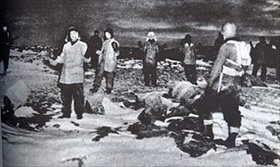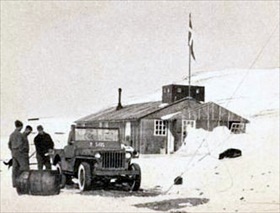ROOSEVELT SENDS TROOPS TO OCCUPY GREENLAND
Washington, D.C. • April 10, 1941
On April 9, 1941, a full year after Operation Weseruebung had brought Denmark and Norway into Nazi Germany’s orbit, the Danish ambassador in Washington, D.C., Henrik Kauffmann, signed an executive agreement with the U.S. Secretary of State, Cordell Hull, authorizing the U.S. to protect the remote Danish colony of Greenland “against attack by a non-American power” and to construct military stations on the island for that purpose. (Greenland, populated then by 18,000 native Iniut and less than 500 Danes, is separated from Canada’s Ellesmere Island to the north by only 16 miles.) The Danish envoy, notable for refusing to recognize the Nazi occupation of his country, was supported in his move by Danish diplomats in the U.S.
Kauffmann was also supported by Danish authorities in Greenland, who were keenly aware of the difficulties the mother country faced in governing the island. After Germany’s occupation of their country, Danish authorities in Greenland’s administrative capital at Godthaab (today’s Nuuk) declared the island to be a self-ruling territory under a 1925 Danish emergency law. After debating among themselves, they agreed to recognize Kauffmann as their representative in Washington. By signing the U.S. treaty “in the name of the King,” Kauffmann ignored instructions from his home government and acted in clear violation of his diplomatic powers. Indeed, the treaty, while affirming Greenland’s loyalty to Denmark, was disavowed by authorities in Copenhagen in part because it allowed the U.S. to establish naval and air bases on Danish territory. (Although occupied by German armed forces, Denmark still regarded itself a neutral country.) The Danish government eventually charged Kauffmann with treason for his independent political moves. (After the war the Danish Parliament revoked Kauffmann’s treason sentence and legalized U.S. military installations in Greenland.)
On this date, April 10, 1941, one day after the signing ceremony, President Franklin D. Roosevelt played his trump card by declaring Greenland to be part of the Western Hemisphere. This declaration brought Greenland under the provisions of the Monroe Doctrine, which U.S. presidents had used to oppose European interference in the Americas for over a century. The inclusion of Greenland into what the U.S. considered its exclusive playground and the establishment of bilateral diplomatic relations in May was all the more important after Germany had made reconnaissance flights over Greenland, causing concern in Washington circles that Adolf Hitler might try to establish bases on the island for future use against the U.S. (See below, “Greenland’s Role in the ‘Weather War’.”) Greenland’s occupation by American armed forces on the same day as the announcement was followed two months later by the occupation of the strategically located Danish dependency of Iceland in the mid-Atlantic, where U.S. Marines supplemented and eventually replaced British and Canadian service members who had been stationed there since May 10, 1940.
The occupation of Greenland and Iceland brought the Roosevelt administration closer to supporting Great Britain in its Battle of the Atlantic. Henceforth, U.S. Navy vessels extended their convoy patrols to these two territories, both lying along the sea lanes linking the U.S. to its future ally against Nazi Germany.
Greenland’s Role in the “Weather War”
 |  |
Left: Predicting the weather became an integral part of World War II intelligence gathering. Information on the weather was vital for planning and executing military operations for both belligerent sides. For their part, the Western Allies mutually agreed to censor themselves in open radio transmissions when reporting comprehensive weather data (pressure, wind, temperature, etc.) that could be of value to Nazi Germany. From their base in occupied Norway, the Germans for their part set up four secret weather stations on Greenland’s meteorologically strategic eastern shore. A special weather-reconnaissance unit of the Luftwaffe, the Grossraum Wettererkundungsstaffel—Wekusta for short—flew in supplies. The stations were intended to provide the Wehrmacht (German armed forces) with advance weather information for the dual purpose of assisting their submarine, surface, and air campaign against Allied merchant shipping transiting the North Atlantic between North America and Great Britain and predicting the weather situation in the European Theater as much as 72 hours in advance. (The Germans—actually the armed U‑boat crew of U‑537 on its first patrol—briefly established a remote automatic weather station, Weather Station Kurt, in Martin Bay on the northern tip of Labrador, Newfoundland, on the North American continent in October 1943 and another one, Schatzgraber (“Treasure Hunter”), in the Soviet (Russian) Arctic from 1942 to July 1944 on remote Alexandra Land Island, the westernmost island of the Franz Josef Archipelago, which researchers uncovered only in 2016.) From their own weather stations in Greenland the Allies gathered weather data to plan their invasion of Normandy, France, in June 1944. As poor as the photo in the left frame is, it depicts captured members of the German Edelweiss II weather station on Little Koldewey Island on October 4 or November 4, 1944 (sources vary), weeks after the capture of Edelweiss I by the crew of the United States Coast Guard cutter Northland. Edelweiss II was the last of the German weather stations in Greenland.
![]()
Right: To show the Allies their willingness to fight the Germans in the Arctic desolation of their homeland, a small band of Danes, Norwegians, and native Greenlanders, 15 men in all, came together as the North-East Greenland Sledge Patrol in the summer of 1941. The birth of the patrol was coordinated with the U.S. Coast Guard. The patrol’s activities were to locate and eliminate German radio and weather stations in Greenland. In March 1943 a dog-team patrol discovered the German weather reporting station Holzauge at Hansa Bay on the northeast coast, where it had been operating since August 1942. In May 1943 U.S. aircraft from Iceland bombed the station, the only offensive air attack on the Greenland mainland during the war. The photo in the right frame shows the headquarters of the Sledge Patrol in the Northern District at Daneborg/Sandodden, Greenland. A flagpole with the Danish flag sits atop the building.
Newsreel Clip from 1944 Showing the Destruction of a German Radio and Weather Station in Greenland
![]()

 History buffs, there is good news! The Daily Chronicles of World War II is now available as an ebook for $4.99 on Amazon.com. Containing a year’s worth of dated entries from this website, the ebook brings the story of this tumultuous era to life in a compelling, authoritative, and succinct manner. Featuring inventive navigation aids, the ebook enables readers to instantly move forward or backward by month and date to different dated entries. Simple and elegant! Click
History buffs, there is good news! The Daily Chronicles of World War II is now available as an ebook for $4.99 on Amazon.com. Containing a year’s worth of dated entries from this website, the ebook brings the story of this tumultuous era to life in a compelling, authoritative, and succinct manner. Featuring inventive navigation aids, the ebook enables readers to instantly move forward or backward by month and date to different dated entries. Simple and elegant! Click 











